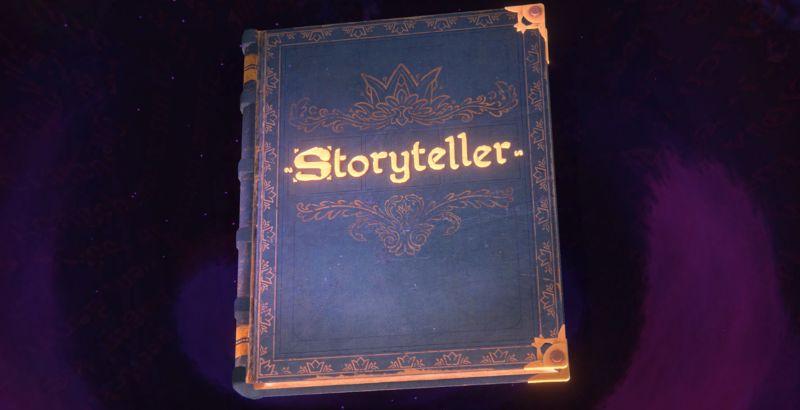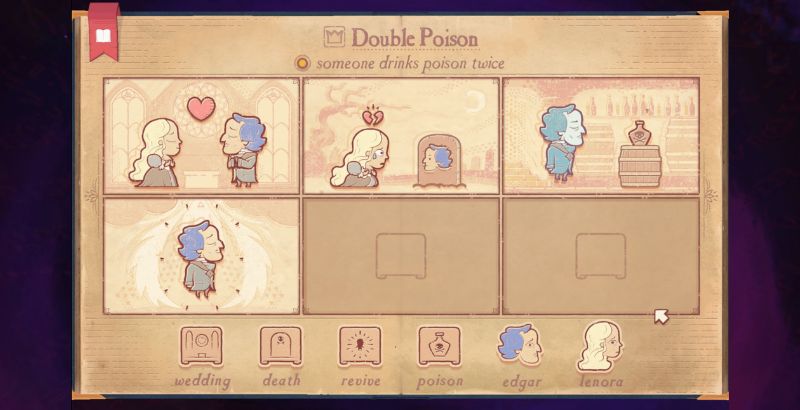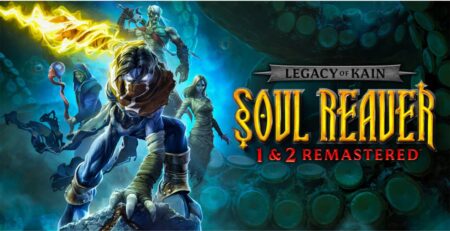
Good puzzle games are hard to come by. Many don’t seem to find the right balance of teaching the player and extrapolating on their own rules to add challenge. Even then, there’s an even harder challenge to stand out. Storyteller, developed by Daniel Benmergui and published by Annapurna Interactive, found a way to do all three. When first revealed in July of 2021, Storyteller quickly became one of my most anticipated games because of its unique aesthetic and interesting approach to the puzzle game genre. Now that it’s here, did it meet every expectation? Absolutely.
Ironically, Storyteller doesn’t have much of a story. You’re given a magical storybook, and your goal is to complete every story to get a crown. The catch is all you’re given is a prompt, characters, and scenes. It’s up to you to piece the story together to fit the prompt. These prompts cover basic love stories to modern classics like Dracula, the Werewolf, Oedipus, Romeo and Juliet, and more. They’re simple retellings. Yet the ways they can be told are many, letting your imagination drive the stories being told.
My first reaction was this game was short. It took me about two and a half hours to complete. The thing is, that time flew by so quickly. It wasn’t a blink-and-it’s-over type of fast, rather, I just had too much fun solving these puzzles. But it wasn’t because the puzzles were challenging or thought-provoking; it’s because it uses its aesthetic to create enjoyable (and hilarious) a-ha moments. The art style is similar to a child’s storybook, with settings simple and exaggerated and cartoony characters. For example, when you think of an evil witch, what do you imagine? Is it similar to a small old woman with a long crooked nose? Because that’s the exact queen that’s used here. Same for an angry dwarf, who looks very similar to Grump from Snow White and the Seven Dwarves. Even Dracula looks just like a classic look for a vampire.

It’s literally manipulating these classic stories to your whim to reach a simple goal. And that could not have been pulled off without using characters that feel like the best generalization of characters from these stories. Another fantastic part of this game is all the unspoken rules and how it all fits together. You’re told very little about how these characters and settings work together. All you’re really told when you first start the game is how to place the different settings and characters on the storyboard. That’s it. But every character and setting has its own rules and interactions and finding out how they all affect each other is such a blast.
For a quick example, I’m going to go over one of the Dracula scenarios (no spoilers). There’s a forest, a professor’s lab, and a crypt as the settings. Then there’s Dracula, a boy, and a girl characters. If you place either the boy or the girl in the forest with Dracula, Dracula turns that character into a vampire. But, if you place Dracula and that same character in the crypt before the scene, that character finds Dracula sleeping. To solve the prompt, you have to figure out how to fit all that and a character learning how to fix vampirism and add the story’s resolution in a four to six-panel page. And that’s what I love most. You can know the solution. But how do you make it all fit in the number of panels available?
Another genius touch is how the character’s interactions change as you adapt the panels too. If you change an earlier panel, later ones immediately change how they play out. This could give you a hint of if you’re in the right direction. One moment two characters could be mad or upset with each other. The next, one is murdering the other. No resetting the entire page is required if you got something wrong. This especially helped me in later chapters and levels where I knew I was missing one key portion of a puzzle. If one panel changed the entire ending of the story I was working with, I could quickly try different scenarios to get the outcome I wanted.

Finally, for an added challenge, there are special variables that appear after finishing some stories. For instance, an initial prompt could be, “A father gets killed by his daughter.” After finishing the level, it could add, “… but he was trying to help her”. So how do you change the initial scenario you found that worked to fit both of these criteria? Each one is a really fun and interesting way to think outside the box to not only either change the destination but the journey getting there. I only wish every level had a challenge mode option, especially after beating the game when I wanted so much more Storyteller.
Storyteller is full of charm, laughs, and head-scratching puzzles. All are made in a way that lets you create the story you want to tell to fit the prompt. With standouts like its hands-off instructions to subtle butterfly effect interactions, this is a can’t-miss game for anyone looking for a new puzzle game to sink their teeth into. Even without its own story, its implementation of classic tales is great, and how you can put your own spin on them is even greater. All I want now after beating it is so much more.
Storyteller releases March 23, 2023 on Nintendo Switch, PC, and Mac operating systems.
Storyteller
-
Rating - 9/109/10
TL;DR
Storyteller is full of charm, laughs, and head-scratching puzzles. All are made in a way that lets you create the story you want to tell to fit the prompt. With standouts like its hands-off instructions to subtle butterfly effect interactions, this is a can’t-miss game for anyone looking for a new puzzle game to sink their teeth into.




